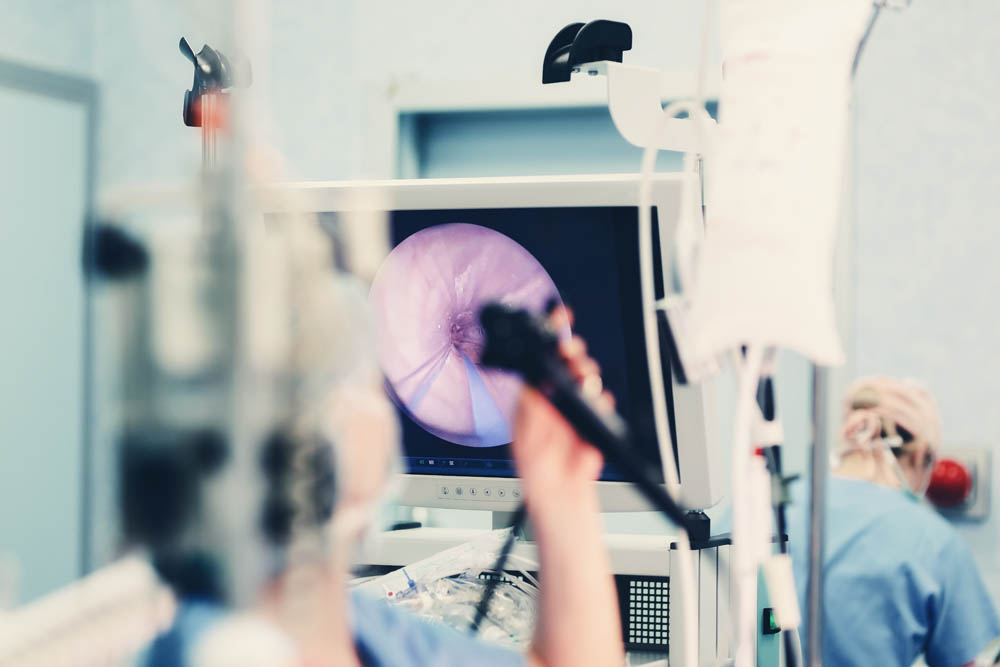Gynaecological Laparoscopic Surgery in Singapore
Home Gynaecology Laparoscopic Surgery
Gynaecological conditions can disrupt a woman’s life, from her physical well-being to her emotional stability. Without knowing what to expect or how to treat them, women may find themselves grappling with uncertainty about their bodies and their futures.
Fortunately, laparoscopic surgery offers solutions to a wide range of reproductive health issues.

What conditions can be treated with gynaecological laparoscopic surgery?
Gynaecological laparoscopic surgery uses small surgical incisions and a laparoscope—a thin, lighted tube equipped with a camera—to view, diagnose, and treat gynecologic disorders. This approach provides a clear view of the pelvic organs, allowing surgeons to perform complex surgeries with precision.
Most gynaecologists prefer laparoscopic surgery because it minimises trauma to the body, reduces the risk of complications, and shortens recovery times. Unlike traditional open surgery, which requires large incisions, laparoscopic surgery uses small incisions of 0.5 to 1 cm that significantly reduce scarring and post-operative pain.
It is especially beneficial in gynaecology, where delicate structures like the uterus, ovaries, and fallopian tubes need careful handling. With its minimally invasive approach, laparoscopic surgery reduces the need for open abdominal surgery, thereby minimising patients’ discomfort and downtime.
Laparoscopic surgery is suitable for treating gynaecological conditions such as those below.
- Abnormal uterine bleeding
- Adenomyosis
- Uterine fibroids
- Pelvic pain
- Menstrual cramps (dysmenorrhea)
- Endometriosis
- Ovarian cyst
- Heavy menstrual periods
- Ectopic pregnancy
Abnormal uterine bleeding
Adenomyosis
Uterine fibroids
Pelvic pain
Menstrual cramps (dysmenorrhea)
Endometriosis
Ovarian cyst
Heavy menstrual periods
Ectopic pregnancy
Laparoscopic Surgery for Adenomyosis
Adenomyosis develops when the inner lining of the uterus grows into the uterine muscle, causing pain, heavy periods, and bloating. Laparoscopic surgery is often recommended when adenomyosis symptoms significantly impact your quality of life and other treatments have failed.
Laparoscopic surgery for adenomyosis involves removing the affected tissue while preserving the uterus when possible. Depending on the extent of the surgery and the remaining uterine health, pregnancy is still possible after laparoscopic surgery. It is advisable to discuss your fertility goals with your surgeon. In severe cases, a laparoscopic hysterectomy may be performed.
Benefits Over Traditional Open Surgery
- Smaller incisions and minimal scarring
- Faster recovery and reduced hospital stay
- Lower risk of infection and blood loss
Preparation Tips
- Follow your doctor’s instructions about fasting and medications.
- Arrange for a family member or friend to accompany you home post-surgery.
Keyhole Endometriosis Surgery: Laparoscopy
Keyhole surgery is another name for laparoscopy, referring to the small incisions made during the procedure. For endometriosis, laparoscopy is used to locate and remove endometrial tissue growing outside the uterus.
Keyhole endometriosis surgery is recommended for women experiencing severe pain, infertility, or other debilitating symptoms that do not respond to non-surgical treatments. While the surgery removes existing lesions, endometriosis can recur. Regular follow-ups and lifestyle modifications can help manage symptoms.
Benefits Over Traditional Open Surgery
- Precise removal of endometrial lesions
- Less damage to surrounding tissues
- Quicker return to daily activities
Preparation Tips
- Do not eat or drink for 8–12 hours before surgery.
- Discuss any medications you’re taking with your doctor.
Laparoscopic Surgery to Remove Ovarian Cysts
An ovarian cyst is a sac of fluid that grows on or inside an ovary. Although most are benign, some cysts can cause discomfort as they become larger. A laparoscopic surgery is recommended for the removal of large ovarian cysts, those causing pain, or cysts suspected of being cancerous.
It can remove cysts without damaging the ovaries, through small incisions and using tools inserted alongside the laparoscope. Cysts up to 10 cm in size are typically removed laparoscopically, but larger ones may also be managed based on the surgeon’s expertise.
Benefits Over Traditional Open Surgery
- Reduced scarring and faster healing
- Lower risk of complications
- Preservation of healthy ovarian tissue
Preparation Tips
- Stop medications as advised by your doctor.
- Arrange for someone to assist you during recovery.
Laparoscopic Surgery for the Removal of Uterus Fibroids (Myomectomy)
A fibroid is a growth that develops in or on the muscular walls of the uterus. They can grow to sizes as small as a seed to as large as a melon and can appear in different parts of the uterus. Laparoscopic myomectomy is a surgery that removes fibroids while preserving the uterus, making it suitable for women who want to maintain fertility. A doctor will advise you on this procedure if the fibroids cause heavy bleeding, pain, or fertility issues.
Fibroids up to 10–12 cm can be removed using laparoscopic techniques. However, patients with very large fibroids may be advised to undergo alternative surgical options, such as traditional open surgery, for safer removal.
Benefits Over Traditional Open Surgery
- Preservation of uterine structure
- Reduced recovery time
- Minimal blood loss
Preparation Tips
- Follow pre-surgery dietary and medication guidelines.
- Plan for a few weeks of limited physical activity.
Laparoscopic Hysterectomy
A laparoscopic hysterectomy is a surgery that performs the removal of the uterus through small abdominal incisions, guided by a camera. While it is often considered a last resort, it is recommended for treating severe gynaecological conditions that do not respond to less invasive treatments.
Some conditions that warrant the removal of the uterus include severe endometriosis, fibroids, or uterine prolapse. A laparoscopic hysterectomy procedure may take 2–4 hours, depending on the complexity of each case.
Benefits Over Traditional Open Surgery
- Smaller incisions and quicker recovery
- Reduced hospital stay
- Less post-operative pain
Preparation Tips
- Prepare for the possibility of hormonal changes post-surgery.
- Follow your doctor’s fasting and medication instructions.
Dos and Don’ts
- Do: Rest and avoid heavy lifting during recovery.
- Don’t: Ignore unusual symptoms like severe pain or fever.
What is the Role of Laparoscopic Surgery in Fertility & Infertility?
Laparoscopic surgery provides a comprehensive view of the pelvic and abdominal cavities, allowing for accurate diagnosis of conditions that may hinder conception, such as endometriosis, pelvic adhesions, and ovarian cysts.
Moreover, laparoscopic surgery allows for therapeutic interventions that can enhance fertility. These interventions include:
-
Ovarian drilling for Polycystic Ovary Syndrome (PCOS) to encourage ovulation
-
Excision of endometrial lesions to improve reproductive outcomes
-
Tubal cannulation to open blocked fallopian tubes
With its precise approach and minimally invasive nature, laparoscopic surgery can significantly enhance fertility outcomes.
How long is recovery after gynaecological laparoscopy?
Recovery time after gynaecological laparoscopy varies depending on the procedure. However, most patients can expect the following:
-
Return to normal activities within 1-2 weeks
-
Swelling and soreness around the surgical site in the first 24 to 48 hours following surgery
-
Abdominal cramping, nausea, and increased urination due to the gas used during the procedure
Remember that recovery rates differ from person to person. Consult your doctor for specific recovery instructions based on your case.

What are the potential risks of gynaecological laparoscopic surgery?
Although gynaecological laparoscopic surgery is generally safe, like any surgical procedure, it carries potential risks. These include:
-
Infection
-
Bleeding
-
Injury to surrounding organs
-
Complications associated with anaesthesia
The overall incidence of major complications during gynaecological laparoscopic surgery is relatively low but it’s vital to speak to your doctor about any concerns you have.

Gynaecological laparoscopic surgery in Singapore
Gynaecological laparoscopic surgery is suitable for treating various women’s health conditions. With the benefits of smaller incisions, reduced postoperative pain, and quicker recovery time, it is a convenient treatment option for women with gynaecological conditions.
Our clinic offers minimally invasive gynaecological surgery. Whether you’re seeking relief from chronic pelvic pain, exploring fertility options, or considering surgical management for uterine fibroids, Dr TC Chang is committed to helping you with a solution.
Frequently Asked Questions
The recovery time after a gynecologic laparoscopy varies depending on the procedure. However, most patients return to normal activities within 1-2 weeks.
Some common side effects of laparoscopic surgery include nausea, abdominal cramping, and increased urination due to the gas used during the procedure. Some patients may also experience changes in bowel habits for a few days following surgery.
Laparoscopic myomectomy is less invasive than open surgery, but it is still considered a major surgery as it involves the removal of uterine fibroids.
Laparoscopic myomectomy is generally associated with less postoperative pain and a quicker return to normal routine compared to open myomectomy. However, an open myomectomy may be necessary in cases of large, multiple, or deeply embedded fibroids.
Laparoscopic surgery has smaller incisions, less postoperative pain, faster recovery, and minimal scarring, compared to open surgery.
Laparoscopic gynaecological surgery may not be suitable for everyone. Patients with the following conditions may not be ideal candidates for the procedure:
- Patients with large fibroids or cysts beyond safe size limits.
- Women with extensive pelvic adhesions that hinder surgical access.
- Individuals with severe heart or lung conditions, as abdominal inflation may pose risks.
- Cases of suspected malignancy where open surgery offers better access for treatment.